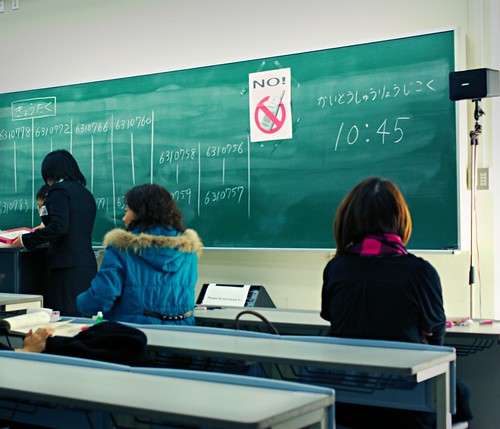If you have been here for a while and haven't commented, the invitation is always open. There are also many other ways to connect, become a fan on Facebook, follow me on Twitter. If this is your first time here this post will thread a path for you through the archive, and is probably a good way to get to know me better. If you like what you read, please pick up the feed.

Teacher/Pupil: Twitter 19/365
Got to know where you've come from to know where you're going.
I started January with Japan Blog Matsuri post about keeping yourself open to possibilities when travelling to Japan or preparing to live there. The inspiration for getting back into blogging was provided by Chris from Nihongo Notes who blogged about getting over your perfectionist streak. Thanks Chris, your insights helped unblock my inner blogger and helped get this blog back on track.
The message I have is still pretty much the same, maintaining an open mind and understanding your motivation is most important if you want to make the most of the Japanese experience. Any experience you have is yours alone to have, so I asked you what's your flavour of Japanese? A post by Jon on the Kurosawa classic Rashomon had me thinking how inseparable culture and language are. Your perception invariably influences your version of reality.
Get your blog on.
One of the most commented on posts of the year asked if learning Japanese loanwords make you lazy. The post actually lay dormant for quite sometime until I submitted it to JapanSoc and it got picked up on Twitter. I was responding to a mothballed review written in 2001 of Giles Murray's entertaining book of techniques for learning Japanese reviewed elsewhere on this blog. It showed me how a little controversy can go a long way to getting some posts noticed.
In February I posted three ways to enjoy Japanese curry rice, another Japan Blog Matsuri organised by Deas from Rocking in Hakata. Mid month I spent two weeks in Japan before coming back for more eduFire where I learnt that teaching in more than one time zone can be tough. With the exception of Field Mice and Japanese Mnemonics most of my lessons since have been at times that make it hard for those in Australia and Japan to take part. So hello North America and Europe, the Middle East and South Asia!
In March I investigated how reading Manga can be good for your Japanese and how there is always room for humour with some bad Japanese puns. I followed up in April with a guide to learning Japanese through manga with the help of my Twitter friend @natuskigirl.
One thing that I must learn how to do well is some kind of weekly link post. I toyed with the idea of sharing links that my students share in the eduFire classroom and did a photographic retrospective of Spring Sumo tournament. These kinds of posts probably should happen more often, but they also need to contribute a more to the blog than just an automated dump of delicious links or a Flickr feed. April was also the where I tapped into 6 ex-pat perspectives on Japan, a theme I continued with 7 J-bloggers far from Japan in June.
The rise and demise of Superpass.
Superpass was launched in June, and discontinued in December. In that short time it provided me with enough momentum to attract over 300 students to my classes on eduFire, so I'm grateful for it. I'll be exploring new ways to maintain that momentum in the new year, and will continue to produce top content and articles relevant to studying the Japanese language. I'll be looking for ways to offer exclusive discounts to existing students and readers of my blog. Get in early for a subscription to my email newsletter, launching in the new year where you can learn about these discounts first.
Moving forward.
Part of the formula for attracting and supporting new students has been the goals I create on smart.fm. I blogged about the introduction of colloborative smart.fm goals in July, and not much else. I got back in to the swing of things with a guest post on Caught*Red-handed about the history of written Japanese and organised a forum for students of Japanese students on eduFire. There was also a bit of fun with bottom grabbing on Twitter.
In September it was all about the JLPT and test preparation with a five step series to ace the JLPT. The five posts outlining the five steps were also completed in 5 days, which was a bit of an experiment in speed blogging. I was also lucky enough to be able to give away a free month of SuperPass to @aggettzz who was overjoyed. I found posting a series of blogs to complement my classes on eduFire helped maintain my motivation. In October I began a book review of 13 Secrets for Speaking Fluent Japanese, a text I've been using in my Fast Track to Fluency classes.
My network on Twitter has been a fabulous source of inspiration for blogging, and even a source of answers where I am unable to provide them to my students. I find every time I'm asked a question that people really want to know, like "what are the best apps for learning Japanese on iPhone?" I get the best answers from my Twitter friends.
Again in November I asked if my friends were using a monolingual Japanese dictionary and came up with 3 good reasons to use a Japanese only dictionary. I had previously written an article for eduFire How to Choose the Best Japanese Dictionary, but I wanted to go into more detail about discovering new vocabulary using a Japanese monolingual dictionary.
By the end of November most people studying Japanese were preparing for the Japanese Language Proficiency Test. I could probably do a lot better at rounding up resources for the JLPT, but it's a long way off now and there is plenty of time. At least I have a game plan for how I'd like to approach the JLPT in 2010.
Thank you for reading.
It has been a big year, and I have lots of people to thank. I'm planning to have an even bigger year in 2010 and I want to get things of to a good start. Why don't you become a fan of the Rainbowhill Language Lab on Facebook or follow @rainbowhill on Twitter. If you have done a lesson with me on eduFire, please tell me what you think, I want to get to know you better. If you haven't already, Get in early for a subscription to my email newsletter. In it you'll find discounts on lessons with me, specific tips for preparing for the JLPT and of course all the best content on Japanese language and culture.
あけましておめでとう
All the best for 2010!



















